3.2 Ground swell
3.2.1 What is swell?
Storms over the ocean with high winds can produce high waves. Once the storm dissipates, or moves away, the waves keep moving across the ocean surface. Waves that have been caused by a distant storm rather than local winds are know as ‘ground swell’ or simply ‘swell’.
At this point, it’s worth us taking a moment to think a bit more about water waves and how they work. A wave is a disturbance in the water surface. When we say that a wave moves across the surface of the sea, what is actually moving is this disturbance and the energy associated with it - not the water itself. This may seem odd - but here’s a simple analogy - imagine an athlete holding the end of a rope and moving it up and down:
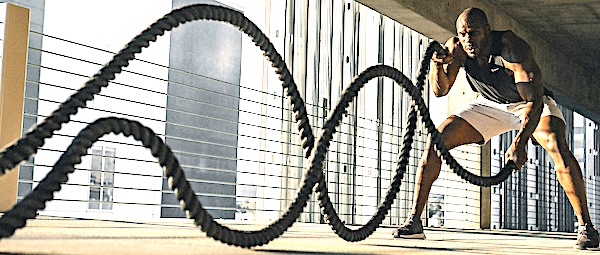
Clearly, there are waves moving along the rope. But the rope is not itself moving away from the athlete. In the same way, water waves move across the sea without causing (very much) net movement of the water.
The water movement inside a wave is a little more complicated than the movement of the rope in our analogy. Rather than just moving up and down, the water also moves side-to-side. In the picture below, the arrows show the direction and speed that each particle of water is moving:
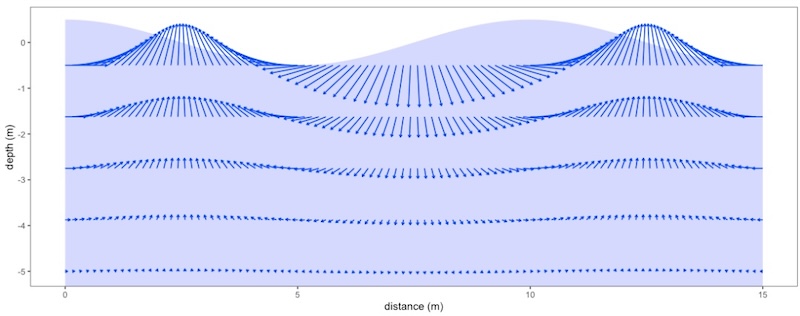
Notice that at the crest and trough, the water is only moving horizontally, whereas halfway up the wave slope, the movement is only vertical. And notice how for this 10 meter long wave, there’s almost no movement at water depths greater than 5 meters - i.e. half the wavelength.
It might be easier to think about what happens to individual bits of water as the wave passes. In animation below, we’re following a series of water particles (red dots), as the wave moves from left to right:
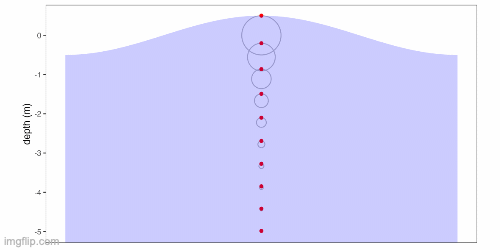
Notice that the particles follow a circular path. The circles become smaller with depth - and again, there’s almost nothing happening by the time we get to a depth equal to half the wavelength - 5 meters for this 10 meter long wave.
3.2.2 Swell propagation
What happens to swell as it crosses an ocean? Clearly, the waves that reach Cornish beaches on a summer’s day are different to the chaotic sea state that existed in the ocean storm that formed them. So how do waves become smaller and more ordered? There’s three things going on - they’re known as ‘circumferential dispersion’, ‘radial dispersion’ and ‘dissipation’.
3.2.2.1 Circumferential dispersion
Imaginee disturbing the water on a flat lake - maybe by dropping a stone in, or perhaps you’re watching a wriggling swan:
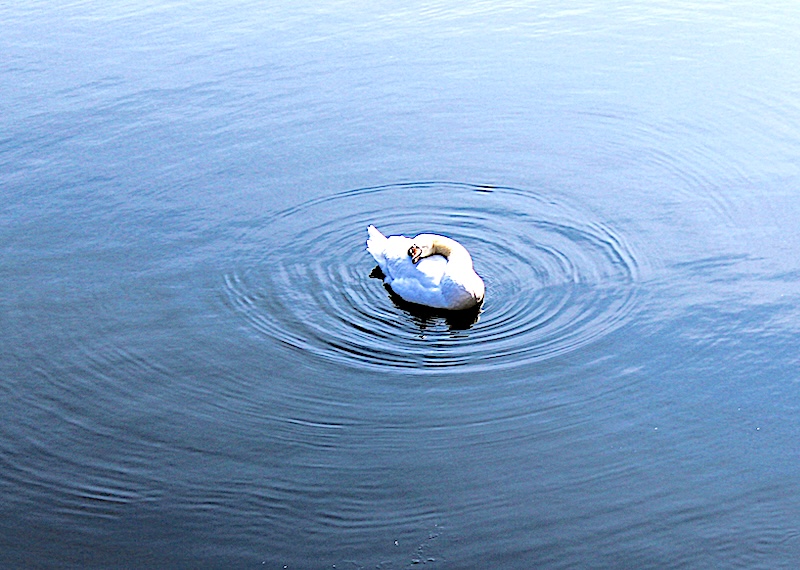
Circular waves form around the swan, spreading out into bigger circles over time. As the waves form bigger circles, they get smaller. This isn’t surprising - the length of the wave crest gets longer, and the energy of the waves spreads across this ever increasing circumference.
The same thing happens to ocean swell as it moves away from a storm:
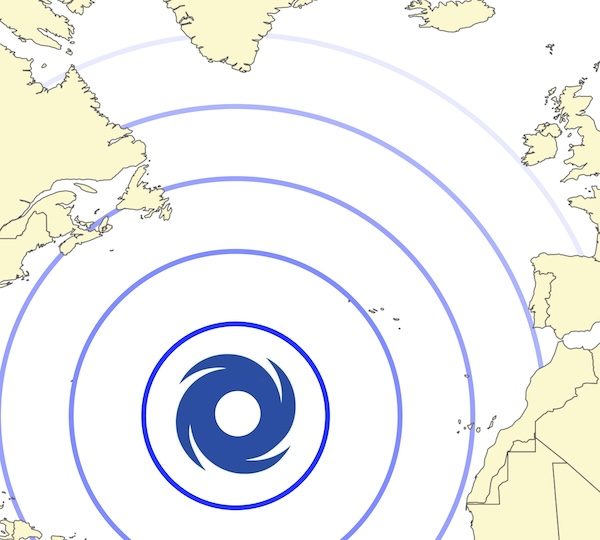
As the waves move away from the mid-Atlantic storm, their crests get ever longer as they fan out. And the wave size drops accordingly.
3.2.2.2 Radial dispersion
The speed at which waves travel depends on their period - longer period waves move quicker. Here’s a few examples:
| Period (seconds) | Wavelength (meters) | Wave propogation speed (knots) |
|---|---|---|
| 5 | 39 | 7 |
| 10 | 156 | 15 |
| 15 | 351 | 23 |
| 20 | 624 | 30 |
(the eagle eyed will notice that the speeds given here are half the wave speeds given earlier - we’ll see why in a moment when we discuss sets).
Storms create a chaotic blend of waves of different heights and wavelengths. As the waves travel away from the storm, the faster long-period waves move quicker than the slower short-period ones. It’s a bit like how runners separate out during a marathon - everyone starts clustered together, but by 20 miles in, the longer-legged runners are out in front, whilst those with shorter strides are left behind.
The diagram below trys to illustrate this in a simplified form. On the left, it shows all the waves in the storm on top of each other - for simplicity waves of period 8, 9, 10… up to 20 seconds are shown:
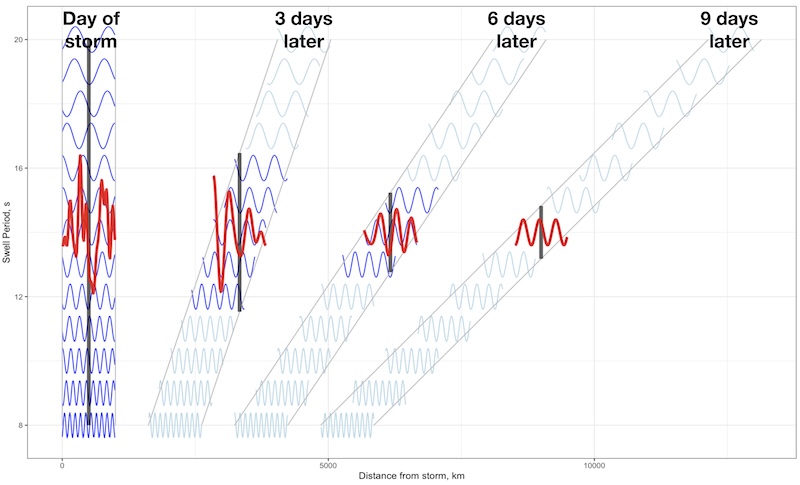
The waves in the storm all superimpose on each other to form a confused sea (red trace).
3 days later, and the long period waves have moved 4000 km from the storm area. But the slower waves have only gone 1500 km. If we take a point 2500 km from the storm centre (vertical black line), we now only see waves from 12 to 16 second periods - the rest are either further ahead or behind. As a result, there’s less energy concentrated into one area of the sea, and the waves have become smaller.
The same thing happens after 6 and then 9 days - notice how less wave periods affect each of the points marked by the vertical black lines, and how the resulting combined red wave trains have got smaller. And the swell has become more organised and regular as the different wave periods separate out.
So we should really update our diagram of the North Atlantic- the energy of the waves doesn’t just spread out circumferentially - it spreads out radially in the direction of swell travel too:
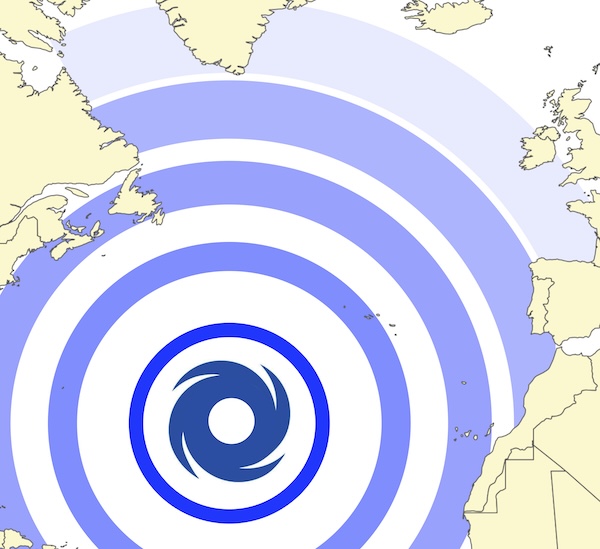
(Note that to avoid the circles overlapping, they’ve been drawn too narrow in this figurative diagram - the plot gives a more accurate picture of the extent of radial dispersion.)
3.2.2.3 Dissipation
So far, we’ve looked at how the energy of the waves spreads out, but not considered whether all the energy of the storm is conserved. Waves do lose some energy as the water molecules rub against each other, and against the air. How much energy is lost and by what processes is still being studied by oceanographers. The surprising thing is how little loss there is, given the vast distances - a swell that’s travelled 8,000 km still retains around half its energy.
The plot below shows how swell heights drop over distance due to the 3 mechanism that we’ve discussed:
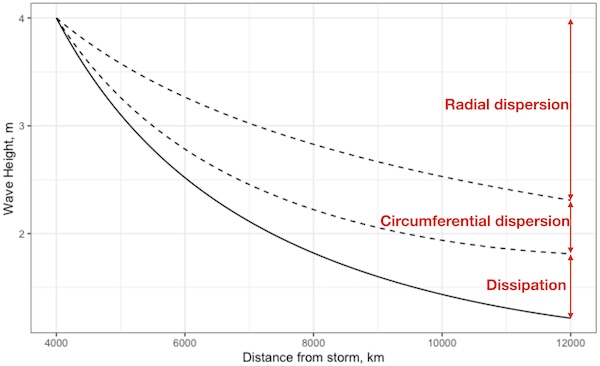
Notice how the wave height initially drops quickly, but then changes much more slowly over remarkably long distances. Most swell will never travel 12,000 km - it’ll hit a shoreline first - but swells have been observed travelling this distance and further from the southern ocean up through the Pacific and as far as Alaska.
3.2.3 Sets
When we looked at radial dispersion above, we briefly considered how waves of different period superimpose to create a chaotic sea. And we saw that far from the storm, the waves sort themselves out so that only waves of a similar period end up travelling together. However, even waves of similar periods will interact with each other to produce more complicated sea surfaces:

In the diagram, simple wave train A is added to simple wave train B to produce the more complex wave train C. Because A and B don’t have exactly the same period, they don’t line up perfectly. Notice how where the peaks of A and B line up, the resulting waves are large. But when a peak lines up with a trough, the waves cancel out to produce a flat area.
The result is several groups of waves. We call these ‘sets’. You’ll often notice that a set of several larger waves break on the shore, followed by a series of smaller ones. The exact form of these sets (e.g. how many waves are in each, what’s the gap between them) still isn’t well understood, but it can have a big effect on the safety of both surfing and rockhopping.
These sets have some curious behavior if we observe them over time. Here’s a few diagrams of a wavetrain with ~10 second period waves over a period of about 90 seconds:
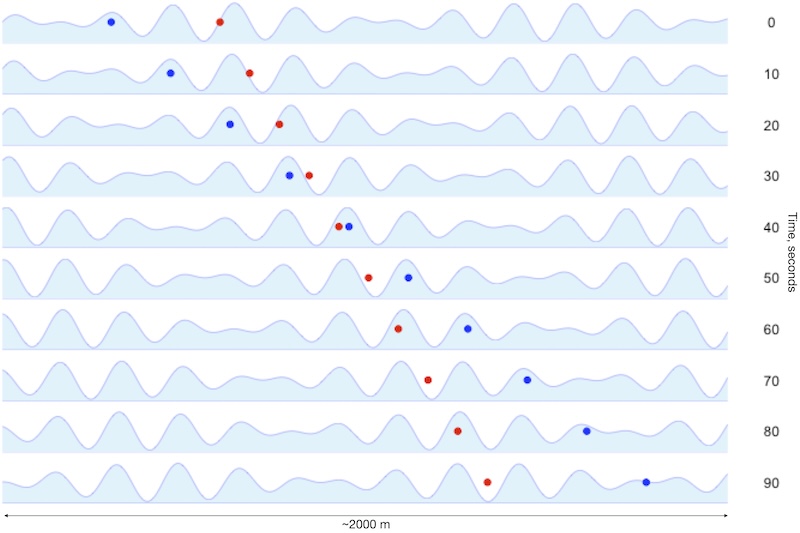
To make things clearer, one of the wave peaks has been labelled with a blue dot, and the center of one of the sets has been labelled with a red dot. The blue dotted wave starts at the back of one of the sets, then moves forward, reaching the middle of the set around 40 seconds later. It keeps moving forward, but reduces in height and disappears from the front of the set by 90 seconds.
While the individual waves are moving at 30 knots, the sets are only moving at 15 knots - half the wave speed. It turns out that the wave energy moves at the speed of the sets, so that wave trains move across the oceans at the speed of the sets - about half the speed of the individual waves. And waves are constantly appearing at the back of the sets, moving through them and disappearing.

This behavior isn’t normally of direct relevance to sea kayakers, as we rarely see this happening given the time and distance scales involved. However, it becomes important when wave interact with tidal streams. You’ll sometimes see waves form, move through a set and disappear again when wave trains become trapped in tide races.